Shipping Nationwide

Shipping Nationwide

Overview
- This article delves into the versatile uses of built-up beams in construction, highlighting their critical role in supporting heavy loads, spanning large spaces, enhancing architectural designs, and forming sturdy frameworks for multi-story buildings.
- Each example illustrates their essential function and adaptability in meeting diverse structural needs, especially in demanding environments.
Built-up beams are fundamental components in advanced structural engineering and construction. These beams are crafted by assembling multiple steel sections, which are then connected through welding or bolting. They are commonly utilized in various settings requiring enhanced structural support and load-bearing capacity that single-rolled or standard beams cannot provide.
This article answers the pressing question: What are built-up beams commonly used for? This helps you be informed why they are vital in construction projects.
Built-up beams excel in supporting heavy loads, owing to their robust structure formed by assembling multiple steel or timber sections. They are specifically designed to handle the weight and stresses of significant loads, making them ideal for use in industrial facilities where heavy machinery or equipment must be supported safely and effectively.
For instance, these beams are used in assembling automobile plants, forming the framework of the overhead crane systems crucial for moving large, heavy automotive parts like chassis or engines across the plant floor.

These composite beams are pivotal in constructing elevated platforms, such as those needed for industrial operations, observation areas, or storage. Their strength and flexibility allow for creating stable and secure platforms, regardless of the height and load demands.
These beams can be found in heavy industry sectors, such as oil refineries or chemical plants. They are used to construct maintenance platforms around large pieces of equipment such as distillation columns or chemical reactors. As a result, these platforms provide access for workers to perform operational checks, maintenance, and repairs.
Due to their capability to withstand higher loads and span longer distances, built-up beams are frequently used to cover wide open spaces without intermediate columns. This makes them perfect for applications such as auditoriums, gymnasiums, and large hallways, where unimpeded space is crucial.
In such facilities, these beams are utilized to support the roof structure over large playing courts or spectator areas. This allows for a clear, unobstructed view and space. As a result, it eliminates the need for supporting columns that could obstruct sightlines or interfere with sporting activities.

Built-up beams are functional and versatile in aesthetic applications. They can be customized and shaped to meet the specific design requirements of a project, allowing architects to enhance the visual appeal of a structure while maintaining structural integrity.
Architects may design the lobby or atrium using curved or uniquely shaped built-up beams to create an eye-catching structural feature to support the building’s upper floors. This dual functionality is especially valuable in modern architectural designs prioritizing form and function.
In the construction of multi-story buildings or other large structures, these steel beams form an essential part of the sturdy skeletal frame. They provide the necessary structural integrity and resilience required to ensure the safety and stability of large buildings, especially in areas prone to environmental stresses like earthquakes or heavy winds.
For instance, a skyscraper project might incorporate built-up beams to support a multi-story structure and allow it to flex slightly during an earthquake. This reduces the stress on the building, minimizing damage and protecting the inhabitants. Moreover, this is crucial for the safety and longevity of high-rise constructions in seismically active areas. This demonstrates how these beams are integral to modern architectural safety and design.
At Linton Incorporated, we specialize in producing robust built-up beams, also known as composite beams, crafted from top-grade steel or timber sections. Our beams are meticulously assembled and fastened together to form larger, more resilient structures capable of withstanding higher loads and spanning greater distances.
Ideal for applications requiring superior strength and durability, such as supporting heavy machinery, creating vast open spaces without columns, or enhancing architectural aesthetics, our beams ensure reliability and performance.
Construction techniques may evolve but built-up beams already solidify their position as an indispensable element. So, what are built-up beams commonly used for? Their applications are extensive, from supporting immense weight loads in bridges and high-rises to creating elevated platforms and expansive roof spans.
Linton Incorporated is a leader in the fabrication of steel beams, employing a meticulous and efficient approach. We specialize in custom-engineered solutions, meticulously crafting beams that combine optimal material selection with precise welding techniques to achieve exceptional structural strength. Contact us now to learn more about our products and services.